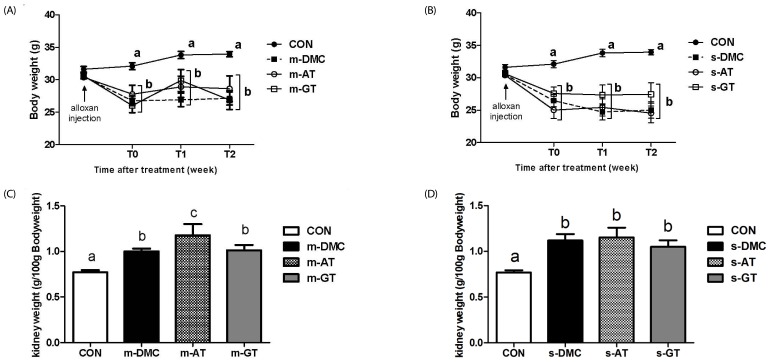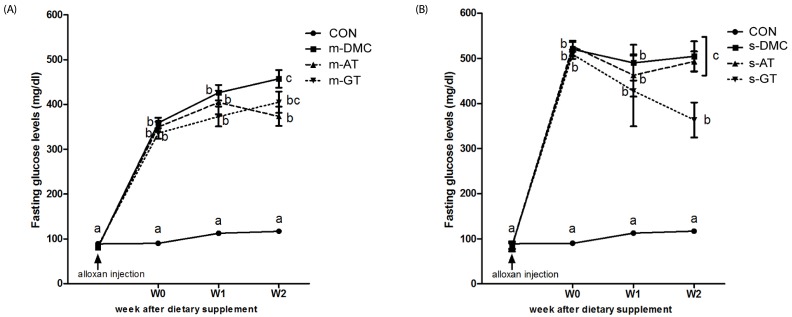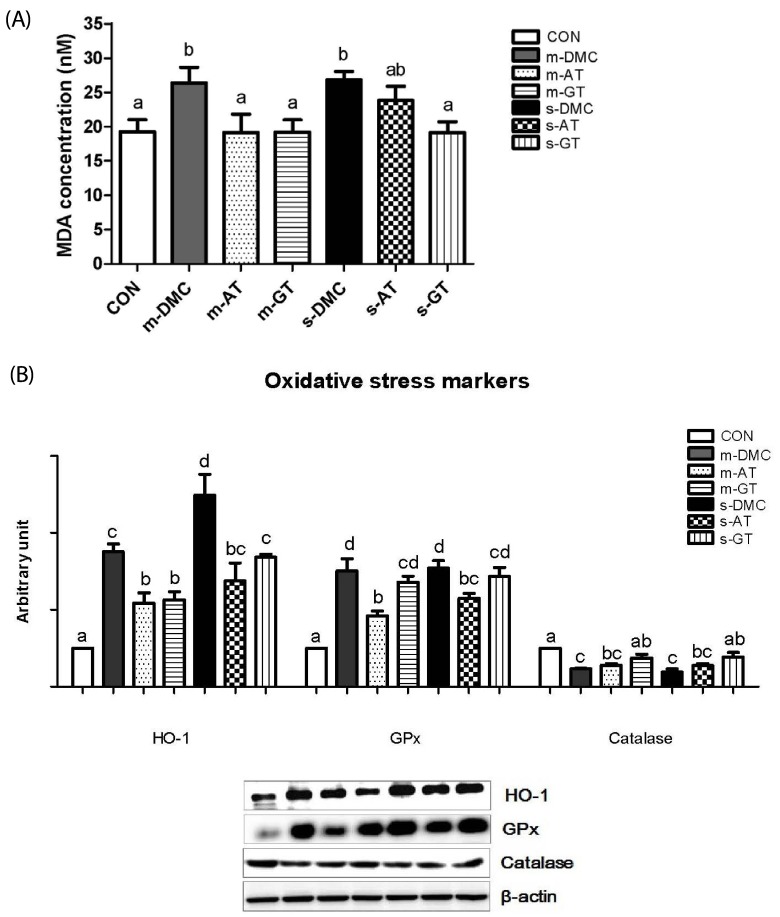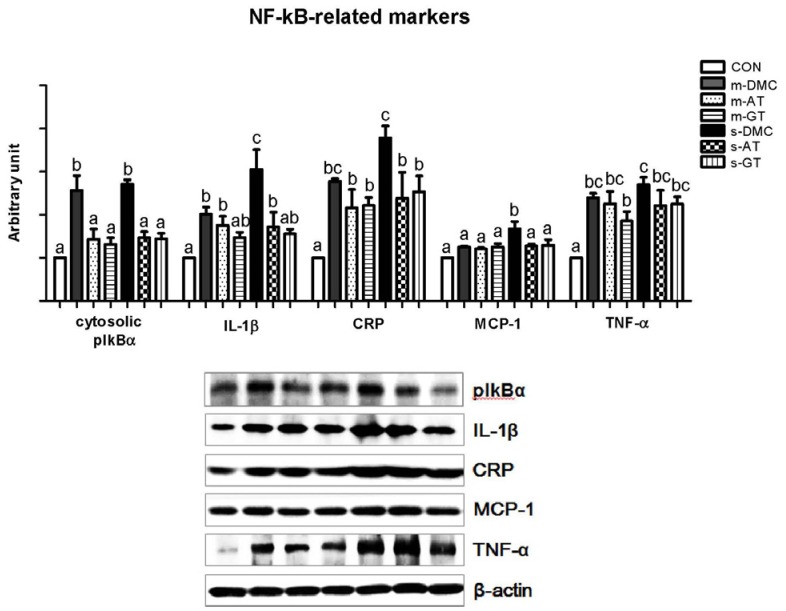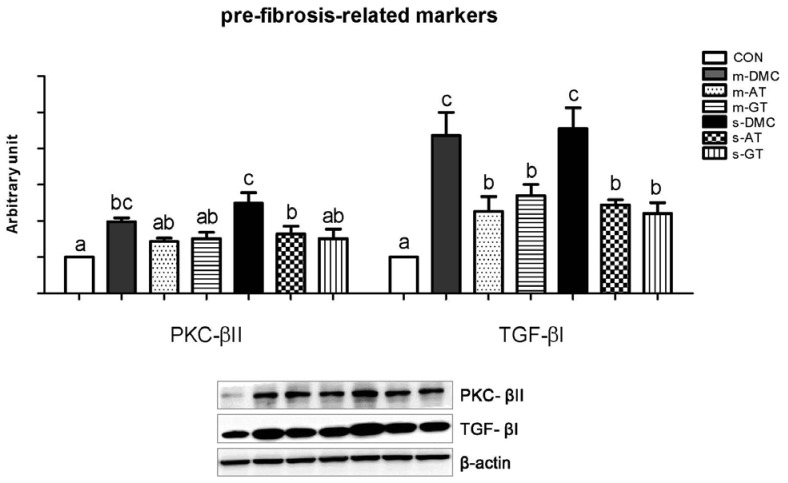Nutr Res Pract.
2016 Feb;10(1):33-41. 10.4162/nrp.2016.10.1.33.
Similarities and differences between alpha-tocopherol and gamma-tocopherol in amelioration of inflammation, oxidative stress and pre-fibrosis in hyperglycemia induced acute kidney inflammation
- Affiliations
-
- 1Department of Food and Nutrition, Kyung Hee University, 26 Kyungheedaero, Dongdaemun-gu, Seoul 02447, Korea. ylim@khu.ac.kr
- KMID: 2313898
- DOI: http://doi.org/10.4162/nrp.2016.10.1.33
Abstract
- BACKGROUND/OBJECTIVES
Diabetes mellitus (DM) is a major chronic disease which increases global health problems. Diabetes-induced renal damage is associated with inflammation and fibrosis. Alpha (AT) and gamma-tocopherols (GT) have shown antioxidant and anti-inflammatory effects in inflammation-mediated injuries. The primary aim of this study was to investigate effects of AT and GT supplementations on hyperglycemia induced acute kidney inflammation in alloxan induced diabetic mice with different levels of fasting blood glucose (FBG).
MATERIALS/METHODS
Diabetes was induced by injection of alloxan monohydrate (150 mg/kg, i.p) in ICR mice (5.5-week-old, male) and mice were subdivided according to their FBG levels and treated with different diets for 2 weeks; CON: non-diabetic mice, m-DMC: diabetic control mice with mild FBG levels (250 mg/dl < or = FBG < or = 450 mg/dl), m-AT: m-DM mice fed AT supplementation (35 mg/kg diet), m-GT: m-DM mice with GT supplementation (35 mg/kg diet), s-DMC: diabetic control mice with severe FBG levels (450 mg/dl < FBG), s-AT: s-DM mice with AT supplementation, s-GT: s-DM mice with GT supplementation.
RESULTS
Both AT and GT supplementations showed similar beneficial effects on NFkappaB associated inflammatory response (phosphorylated inhibitory kappa B-alpha, interleukin-1beta, C-reactive protein, monocyte chemotactic protein-1) and pre-fibrosis (tumor growth factor beta-1 and protein kinase C-II) as well as an antioxidant emzyme, heme oxygenase-1 (HO-1) in diabetic mice. On the other hands, AT and GT showed different beneficial effects on kidney weight, FBG, and oxidative stress associated makers (malondialdehyde, glutathione peroxidase, and catalase) except HO-1. In particular, GT significantly preserved kidney weight in m-DM and improved FBG levels in s-DM and malondialdehyde and catalase in m- and s-DM, while AT significantly attenuated FBG levels in m-DM and improved glutathione peroxidase in m- and s-DM.
CONCLUSIONS
The results suggest that AT and GT with similarities and differences would be considered as beneficial nutrients to modulate hyperglycemia induced acute renal inflammation. Further research with careful approach is needed to confirm beneficial effects of tocopherols in diabetes with different FBG levels for clinical applications.
MeSH Terms
-
Alloxan
alpha-Tocopherol*
Animals
Blood Glucose
C-Reactive Protein
Catalase
Chronic Disease
Diabetes Mellitus
Diet
Fasting
Fibrosis
gamma-Tocopherol*
Glutathione Peroxidase
Hand
Heme Oxygenase-1
Hyperglycemia*
Inflammation*
Interleukin-1beta
Kidney*
Malondialdehyde
Mice
Mice, Inbred ICR
Monocytes
Oxidative Stress*
Protein Kinases
Tocopherols
Alloxan
Blood Glucose
C-Reactive Protein
Catalase
Glutathione Peroxidase
Heme Oxygenase-1
Interleukin-1beta
Malondialdehyde
Protein Kinases
Tocopherols
alpha-Tocopherol
gamma-Tocopherol
Figure
Cited by 2 articles
-
Gamma-tocopherol ameliorates hyperglycemia-induced hepatic inflammation associated with NLRP3 inflammasome in alloxan-induced diabetic mice
Heaji Lee, Yunsook Lim
Nutr Res Pract. 2019;13(5):377-383. doi: 10.4162/nrp.2019.13.5.377.Dietary intake and major source foods of vitamin E among Koreans: findings of the Korea National Health and Nutrition Examination Survey 2016–2019
Jee-Seon Shim, Ki Nam Kim, Jung-sug Lee, Mi Ock Yoon, Hyun Sook Lee
Nutr Res Pract. 2022;16(5):616-627. doi: 10.4162/nrp.2022.16.5.616.
Reference
-
1. Beulens JW, Booth SL, van den Heuvel EG, Stoecklin E, Baka A, Vermeer C. The role of menaquinones (vitamin K2) in human health. Br J Nutr. 2013; 110:1357–1368. PMID: 23590754.
Article2. Kanwar YS, Wada J, Sun L, Xie P, Wallner EI, Chen S, Chugh S, Danesh FR. Diabetic nephropathy: mechanisms of renal disease progression. Exp Biol Med (Maywood). 2008; 233:4–11. PMID: 18156300.
Article3. Tan AL, Forbes JM, Cooper ME. AGE, RAGE, and ROS in diabetic nephropathy. Semin Nephrol. 2007; 27:130–143. PMID: 17418682.
Article4. Itoh K, Wakabayashi N, Katoh Y, Ishii T, Igarashi K, Engel JD, Yamamoto M. Keap1 represses nuclear activation of antioxidant responsive elements by Nrf2 through binding to the amino-terminal Neh2 domain. Genes Dev. 1999; 13:76–86. PMID: 9887101.
Article5. Forbes JM, Coughlan MT, Cooper ME. Oxidative stress as a major culprit in kidney disease in diabetes. Diabetes. 2008; 57:1446–1454. PMID: 18511445.
Article6. Geraldes P, King GL. Activation of protein kinase C isoforms and its impact on diabetic complications. Circ Res. 2010; 106:1319–1331. PMID: 20431074.
Article7. Ma RC, Tam CH, Wang Y, Luk AO, Hu C, Yang X, Lam V, Chan AW, Ho JS, Chow CC, Tong PC, Jia W, Ng MC, So WY, Chan JC. Genetic variants of the protein kinase C-beta 1 gene and development of end-stage renal disease in patients with type 2 diabetes. JAMA. 2010; 304:881–889. PMID: 20736472.8. Border WA, Noble NA. TGF-beta in kidney fibrosis: a target for gene therapy. Kidney Int. 1997; 51:1388–1396. PMID: 9150449.9. Saijo K, Mecklenbräuker I, Santana A, Leitger M, Schmedt C, Tarakhovsky A. Protein kinase C beta controls nuclear factor kappaB activation in B cells through selective regulation of the IkappaB kinase alpha. J Exp Med. 2002; 195:1647–1652. PMID: 12070292.10. Sanz AB, Sanchez-Niño MD, Ramos AM, Moreno JA, Santamaria B, Ruiz-Ortega M, Egido J, Ortiz A. NF-kappaB in renal inflammation. J Am Soc Nephrol. 2010; 21:1254–1262. PMID: 20651166.11. Barkett M, Gilmore TD. Control of apoptosis by Rel/NF-kappaB transcription factors. Oncogene. 1999; 18:6910–6924. PMID: 10602466.12. Baeuerle PA, Henkel T. Function and activation of NF-kappa B in the immune system. Annu Rev Immunol. 1994; 12:141–179. PMID: 8011280.13. Ohga S, Shikata K, Yozai K, Okada S, Ogawa D, Usui H, Wada J, Shikata Y, Makino H. Thiazolidinedione ameliorates renal injury in experimental diabetic rats through anti-inflammatory effects mediated by inhibition of NF-kappaB activation. Am J Physiol Renal Physiol. 2007; 292:F1141–F1150. PMID: 17190910.14. Jangale NM, Devarshi PP, Dubal AA, Ghule AE, Koppikar SJ, Bodhankar SL, Chougale AD, Kulkarni MJ, Harsulkar AM. Dietary flaxseed oil and fish oil modulates expression of antioxidant and inflammatory genes with alleviation of protein glycation status and inflammation in liver of streptozotocin-nicotinamide induced diabetic rats. Food Chem. 2013; 141:187–195. PMID: 23768346.
Article15. Gupta SK, Kumar B, Nag TC, Agrawal SS, Agrawal R, Agrawal P, Saxena R, Srivastava S. Curcumin prevents experimental diabetic retinopathy in rats through its hypoglycemic, antioxidant, and anti-inflammatory mechanisms. J Ocul Pharmacol Ther. 2011; 27:123–130. PMID: 21314438.
Article16. Kim MJ, Lim Y. Protective effect of short-term genistein supplementation on the early stage in diabetes-induced renal damage. Mediators Inflamm. 2013; 2013:510212. PMID: 23737649.
Article17. Sesso HD, Buring JE, Christen WG, Kurth T, Belanger C, MacFadyen J, Bubes V, Manson JE, Glynn RJ, Gaziano JM. Vitamins E and C in the prevention of cardiovascular disease in men: the Physicians' Health Study II randomized controlled trial. JAMA. 2008; 300:2123–2133. PMID: 18997197.18. Shen XH, Tang QY, Huang J, Cai W. Vitamin E regulates adipocytokine expression in a rat model of dietary-induced obesity. Exp Biol Med (Maywood). 2010; 235:47–51. PMID: 20404018.
Article19. Ju J, Picinich SC, Yang Z, Zhao Y, Suh N, Kong AN, Yang CS. Cancer-preventive activities of tocopherols and tocotrienols. Carcinogenesis. 2010; 31:533–542. PMID: 19748925.
Article20. Wu JH, Ward NC, Indrawan AP, Almeida CA, Hodgson JM, Proudfoot JM, Puddey IB, Croft KD. Effects of alpha-tocopherol and mixed tocopherol supplementation on markers of oxidative stress and inflammation in type 2 diabetes. Clin Chem. 2007; 53:511–519. PMID: 17272491.21. Devaraj S, Jialal I. Alpha-tocopherol decreases tumor necrosis factor-alpha mRNA and protein from activated human monocytes by inhibition of 5-lipoxygenase. Free Radic Biol Med. 2005; 38:1212–1220. PMID: 15808419.22. Devaraj S, Jialal I. Alpha-tocopherol decreases interleukin-1 beta release from activated human monocytes by inhibition of 5-lipoxygenase. Arterioscler Thromb Vasc Biol. 1999; 19:1125–1133. PMID: 10195945.23. Jiang Q, Christen S, Shigenaga MK, Ames BN. gamma-tocopherol, the major form of vitamin E in the US diet, deserves more attention. Am J Clin Nutr. 2001; 74:714–722. PMID: 11722951.24. Campbell S, Stone W, Whaley S, Krishnan K. Development of gamma (gamma)-tocopherol as a colorectal cancer chemopreventive agent. Crit Rev Oncol Hematol. 2003; 47:249–259. PMID: 12962899.25. Jiang Q, Ames BN. Gamma-tocopherol, but not alpha-tocopherol, decreases proinflammatory eicosanoids and inflammation damage in rats. FASEB J. 2003; 17:816–822. PMID: 12724340.26. Park NY, Lim Y. Short term supplementation of dietary antioxidants selectively regulates the inflammatory responses during early cutaneous wound healing in diabetic mice. Nutr Metab (Lond). 2011; 8:80. PMID: 22088091.
Article27. Ohkawa H, Ohishi N, Yagi K. Assay for lipid peroxides in animal tissues by thiobarbituric acid reaction. Anal Biochem. 1979; 95:351–358. PMID: 36810.
Article28. Lee R, Galli F, Kelly FJ. γ -Tocopherol metabolism and its relationship with α -Tocopherol in humans. In : Packer L, Traber MG, Kraemer K, Frei B, editors. The Antioxidant Vitamins C and E. Champaign (IL): AOCS Press;2002. p. 180–194.29. Zhao Y, Lee MJ, Cheung C, Ju JH, Chen YK, Liu B, Hu LQ, Yang CS. Analysis of multiple metabolites of tocopherols and tocotrienols in mice and humans. J Agric Food Chem. 2010; 58:4844–4852. PMID: 20222730.
Article30. Ventura-Sobrevilla J, Boone-Villa VD, Aguilar CN, Román-Ramos R, Vega-Avila E, Campos-Sepúlveda E, Alarcón-Aguilar F. Effect of varying dose and administration of streptozotocin on blood sugar in male CD1 mice. Proc West Pharmacol Soc. 2011; 54:5–9. PMID: 22423571.31. Matteucci E, Giampietro O. Proposal open for discussion: defining agreed diagnostic procedures in experimental diabetes research. J Ethnopharmacol. 2008; 115:163–172. PMID: 17961942.
Article32. Kim SS, Gallaher DD, Csallany AS. Vitamin E and probucol reduce urinary lipophilic aldehydes and renal enlargement in streptozotocin-induced diabetic rats. Lipids. 2000; 35:1225–1237. PMID: 11132182.
Article33. Hosten AO. BUN and creatinine. Walker HK, Hall WD, Hurst JW. Clinical Methods: the History, Physical, and Laboratory Examinations. 3rd ed. Boston (MA): Butterworths;1990. p. 874–878.34. Haidara MA, Mikhailidis DP, Rateb MA, Ahmed ZA, Yassin HZ, Ibrahim IM, Rashed LA. Evaluation of the effect of oxidative stress and vitamin E supplementation on renal function in rats with streptozotocin-induced Type 1 diabetes. J Diabetes Complications. 2009; 23:130–136. PMID: 18436458.
Article35. Chang JM, Kuo MC, Kuo HT, Chiu YW, Chen HC. Increased glomerular and extracellular malondialdehyde levels in patients and rats with diabetic nephropathy. J Lab Clin Med. 2005; 146:210–215. PMID: 16194682.
Article36. Salahudeen AK, Kanji V, Reckelhoff JF, Schmidt AM. Pathogenesis of diabetic nephropathy: a radical approach. Nephrol Dial Transplant. 1997; 12:664–668. PMID: 9140991.
Article37. Baydas G, Canatan H, Turkoglu A. Comparative analysis of the protective effects of melatonin and vitamin E on streptozocin-induced diabetes mellitus. J Pineal Res. 2002; 32:225–230. PMID: 11982791.
Article38. Tanaka Y, Maher JM, Chen C, Klaassen CD. Hepatic ischemia-reperfusion induces renal heme oxygenase-1 via NF-E2-related factor 2 in rats and mice. Mol Pharmacol. 2007; 71:817–825. PMID: 17151289.
Article39. Negre-Salvayre A, Salvayre R, Augé N, Pamplona R, Portero-Otín M. Hyperglycemia and glycation in diabetic complications. Antioxid Redox Signal. 2009; 11:3071–3109. PMID: 19489690.
Article40. Das J, Vasan V, Sil PC. Taurine exerts hypoglycemic effect in alloxan-induced diabetic rats, improves insulin-mediated glucose transport signaling pathway in heart and ameliorates cardiac oxidative stress and apoptosis. Toxicol Appl Pharmacol. 2012; 258:296–308. PMID: 22138235.
Article41. Ribeiro G, Roehrs M, Bairros A, Moro A, Charão M, Araújo F, Valentini J, Arbo M, Brucker N, Moresco R, Leal M, Morsch V, Garcia SC. N-acetylcysteine on oxidative damage in diabetic rats. Drug Chem Toxicol. 2011; 34:467–474. PMID: 21770721.
Article42. Piwkowska A, Rogacka D, Audzeyenka I, Jankowski M, Angielski S. High glucose concentration affects the oxidant-antioxidant balance in cultured mouse podocytes. J Cell Biochem. 2011; 112:1661–1672. PMID: 21503956.
Article43. Yoo JH, Erzurum SC, Hay JG, Lemarchand P, Crystal RG. Vulnerability of the human airway epithelium to hyperoxia. Constitutive expression of the catalase gene in human bronchial epithelial cells despite oxidant stress. J Clin Invest. 1994; 93:297–302. PMID: 8282800.
Article44. Kobayashi M, Sugiyama H, Wang DH, Toda N, Maeshima Y, Yamasaki Y, Masuoka N, Yamada M, Kira S, Makino H. Catalase deficiency renders remnant kidneys more susceptible to oxidant tissue injury and renal fibrosis in mice. Kidney Int. 2005; 68:1018–1031. PMID: 16105032.
Article45. Baud O, Greene AE, Li J, Wang H, Volpe JJ, Rosenberg PA. Glutathione peroxidase-catalase cooperativity is required for resistance to hydrogen peroxide by mature rat oligodendrocytes. J Neurosci. 2004; 24:1531–1540. PMID: 14973232.
Article46. Mohamed AK, Bierhaus A, Schiekofer S, Tritschler H, Ziegler R, Nawroth PP. The role of oxidative stress and NF-kappaB activation in late diabetic complications. Biofactors. 1999; 10:157–167. PMID: 10609877.47. Kolb M, Margetts PJ, Anthony DC, Pitossi F, Gauldie J. Transient expression of IL-1beta induces acute lung injury and chronic repair leading to pulmonary fibrosis. J Clin Invest. 2001; 107:1529–1536. PMID: 11413160.48. Dinarello CA. Interleukin-1. Cytokine Growth Factor Rev. 1997; 8:253–265. PMID: 9620641.
Article49. Navarro-González JF, Mora-Fernández C. The role of inflammatory cytokines in diabetic nephropathy. J Am Soc Nephrol. 2008; 19:433–442. PMID: 18256353.
Article50. Barzilay JI, Abraham L, Heckbert SR, Cushman M, Kuller LH, Resnick HE, Tracy RP. The relation of markers of inflammation to the development of glucose disorders in the elderly: the Cardiovascular Health Study. Diabetes. 2001; 50:2384–2389. PMID: 11574423.51. Eklund CM. Proinflammatory cytokines in CRP baseline regulation. Adv Clin Chem. 2009; 48:111–136. PMID: 19803417.52. Himmelfarb J, Kane J, McMonagle E, Zaltas E, Bobzin S, Boddupalli S, Phinney S, Miller G. Alpha and gamma tocopherol metabolism in healthy subjects and patients with end-stage renal disease. Kidney Int. 2003; 64:978–991. PMID: 12911548.
Article53. Sharma K, Ziyadeh FN. Hyperglycemia and diabetic kidney disease. The case for transforming growth factor-beta as a key mediator. Diabetes. 1995; 44:1139–1146. PMID: 7556948.
Article54. Giacco F, Brownlee M. Oxidative stress and diabetic complications. Circ Res. 2010; 107:1058–1070. PMID: 21030723.
Article55. Brownlee M. Biochemistry and molecular cell biology of diabetic complications. Nature. 2001; 414:813–820. PMID: 11742414.
Article56. Koya D, Jirousek MR, Lin YW, Ishii H, Kuboki K, King GL. Characterization of protein kinase C beta isoform activation on the gene expression of transforming growth factor-beta, extracellular matrix components, and prostanoids in the glomeruli of diabetic rats. J Clin Invest. 1997; 100:115–126. PMID: 9202063.
Article57. Meier M, Park JK, Overheu D, Kirsch T, Lindschau C, Gueler F, Leitges M, Menne J, Haller H. Deletion of protein kinase C-beta isoform in vivo reduces renal hypertrophy but not albuminuria in the streptozotocin-induced diabetic mouse model. Diabetes. 2007; 56:346–354. PMID: 17259378.58. Chen S, Jim B, Ziyadeh FN. Diabetic nephropathy and transforming growth factor-beta: transforming our view of glomerulosclerosis and fibrosis build-up. Semin Nephrol. 2003; 23:532–543. PMID: 14631561.59. Sharma K, Jin Y, Guo J, Ziyadeh FN. Neutralization of TGF-beta by anti-TGF-beta antibody attenuates kidney hypertrophy and the enhanced extracellular matrix gene expression in STZ-induced diabetic mice. Diabetes. 1996; 45:522–530. PMID: 8603776.
Article60. Border WA, Noble NA. Evidence that TGF-beta should be a therapeutic target in diabetic nephropathy. Kidney Int. 1998; 54:1390–1391. PMID: 9773681.
- Full Text Links
- Actions
-
Cited
- CITED
-
- Close
- Share
- Similar articles
-
- Gamma-tocopherol ameliorates hyperglycemia-induced hepatic inflammation associated with NLRP3 inflammasome in alloxan-induced diabetic mice
- Vitamin E: alpha-Tocopherol and the Other Forms of Vitamin E
- α-Tocopherol and γ-tocopherol decrease inflammatory response and insulin resistance during the interaction of adipocytes and macrophages
- Modulatory effects of alpha- and gamma-tocopherols on 4-hydroxyestradiol induced oxidative stresses in MCF-10A breast epithelial cells
- Effects of Gamma-Tocopherol (GT) Supplementation on Vitamin E Concentration in Cigarette Smoke (CS) Exposed Mice

